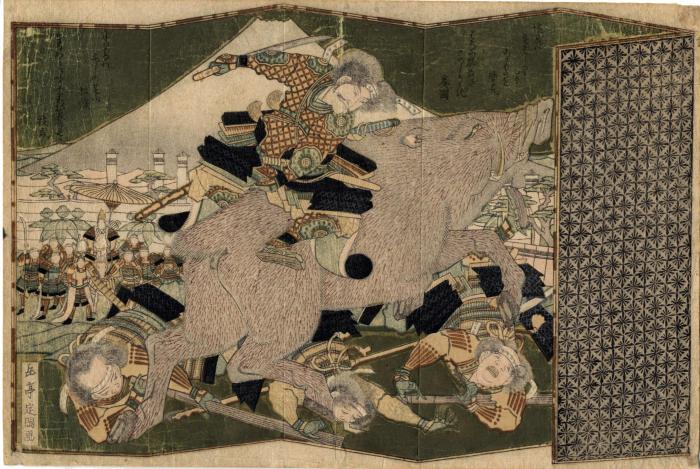Yashima Gakutei (八島岳亭) (artist 1786 – 1868)
Nitan no Shirō (Tadatsune) hunting a wild boar in Yoritomo's hunting party near Mount Fuji
1827
10.75 in x 7.25 in (Overall dimensions) Japanese woodblock print
Signed: Gakutei Sadaoka ga
岳亭定岡画
Museum of Fine Arts, Boston - 19th c. tsuba showing same encounter In Japanese Treasure Tales by Kumasaku Tomita and published by Yamanaka & Company in 1906, on pages 16-17 it says: "Yoritomo - founder of the Shogunate, and himself the first Shogun - settled in Kamakura near Yedo, in 1192 A.D. In the following May, he invited all the great Daimios to meet him on a certain day at the base of Fujiyama, for a great hunting expedition. In obedience to this invitation a great party - popularly said to number ten thousand (the Japanese are very fond of numbers, especially thousands) Daimios and their suites assembled for the purpose under innumerable tents a unique assembly in the history of Japan. On the third day of the hunt, a wild boar, of unusual size and ferocity, although already wounded by four or five arrow shots, dashed towards the Shogun, who, seeing his danger, called to a brave samurai named Shiro Nitta, who was waiting by, to kill the infuriated beast. Without a moment's hesitation, Shiro, as the boar rushed past him, jumped straight from his horse on to the boar's back, holding on with one hand to the creature's tail as if it were a bridle, while with the other he drew his wakizashi (shorter of the two swords worn by gentlemen ) and stabbed the boar deeply five or six times. With a piteous moan the poor beast expired, not falling however, since by the impetus of its desperate flight, its legs remained stuck firmly some four or five inches in the soft ground. Yoritomo, conceiving that he owed his life to Shiro's bravery and resource, as a recognition thereof, endowed him with an estate of five hundred cho [about 150 acres]."
****
There are a number of stories related to the vendetta of the Soga brothers against Suketune, the man responsible for the death of their father. This print by Gakutei illustrates one of those peripheral tales.
Yoritomo and his men, including Suketune, have gone to the foot of Mt. Fuji on a hunting expedition - where the Soga brothers are about to make their move. "During the... expedition, a monstrous boar, roused by beaters, killed some of its tormentors, threw others to the ground and then charged Yoritomo. Without the slightest hesitation, Nitan no Shirō placed himself directly in the beast's path, leapt on its back, and killed it with his dirk.
The dexterity and bravery of the warrior's extraordinary feat is perfectly captured by Gakutei, who chose to represent the moment when Shirō, astride the enormous beast, is just about to slay it. The contrast between the hapless retainers and the confident hero is clearly done. The device of representing the action as if taking place on a six-fold screen emphasizes that this surimono is a New Year's card, in all likelihood for the Year of the Boar, 1827. There are two kyōka on this surimono, each a collaborative work between two poets and each devoted to particular locations associated with Mount Fuji. The first poem makes abstruse comparisons between places on Mount Fuji and parts of the human body. The second poem reads:
tsuwamono no
Fuji no Shibayama
yukinagara
keburite kasumu
haru no hi o
The warrior goes
to Shibayama on Mount Fuji.
There is snow.
It makes the spring sun
hazy and smokey.
Matsutoshi/EdanariSource and quote from: Japanese Warrior Prints 1646-1905 by James King and Yuriko Iwakiri, p. 218.
****
"In 1193, when the great warrior Yoritomo gave a hunting party at the foot of Mount Fuji, a boar suddenly broke cover and,wounded and maddened, headed straight at the hunters, too fast to be hit with their arrows. In an instant the warrior Nitan-no-Shiro Yadatsune sprang from Yoritomo's bodyguard and, casting aside his bow and arrows, and leaping on his horse, he made straight for the boar, which turned to attack him. Like a flash Nitan leaped on the back of the beast, with his own back to the animal's head. Grasping the tail, Nitan clung to the speeding animal until he found a chance to draw his dagger and stab him to death. Thereupon, so it is said, he received an ovation "so great as to shake the surrounding hills." "
Quoted from: The Asian Animal Zodiac by Ruth Q. Sun.
****
In the middle ground is the military camp of Yoritomo with its jinmaku (陣幕) or curtain with his personal clan motif, the sasarindō.
"The personal, rather than clan mon of Minamoto no Yoritomo was the sasarindō, a design in which three flowers of rindō (the Japanese gentian, Gentiana scabra or G. makinoi) sit above three leaves of the shrubby bamboo Sasa. The gentian was characteristic of the damp grassland flora of Southern Japan, while the bamboo was a signature plant of the North. This elegant posy is iconographic code for the shogun: the North is subjugated by the South; the country united under his military authority. The Heike clan took swallowtail butterfly as their badge, suitably flamboyant and fugacious for the high-rolling tribe routed by Yoritomo's Genji."
Quoted from: The Lotus Quest: In Search of the Sacred Flower by Mark Griffiths, p. 245.
****
Illustrated in color in Japanese Warrior Prints 1646-1905 by James King and Yuriko Iwakiri, Hotei Publishing, 2007, p. 219.
surimono - 摺物 (genre)
Historical - Social - Ephemera (genre)
Soga brothers (曾我兄弟) (genre)
Mount Fuji (富士山) (genre)
Jūnishi (十二支 - 12 signs of the Zodiac) (genre)
